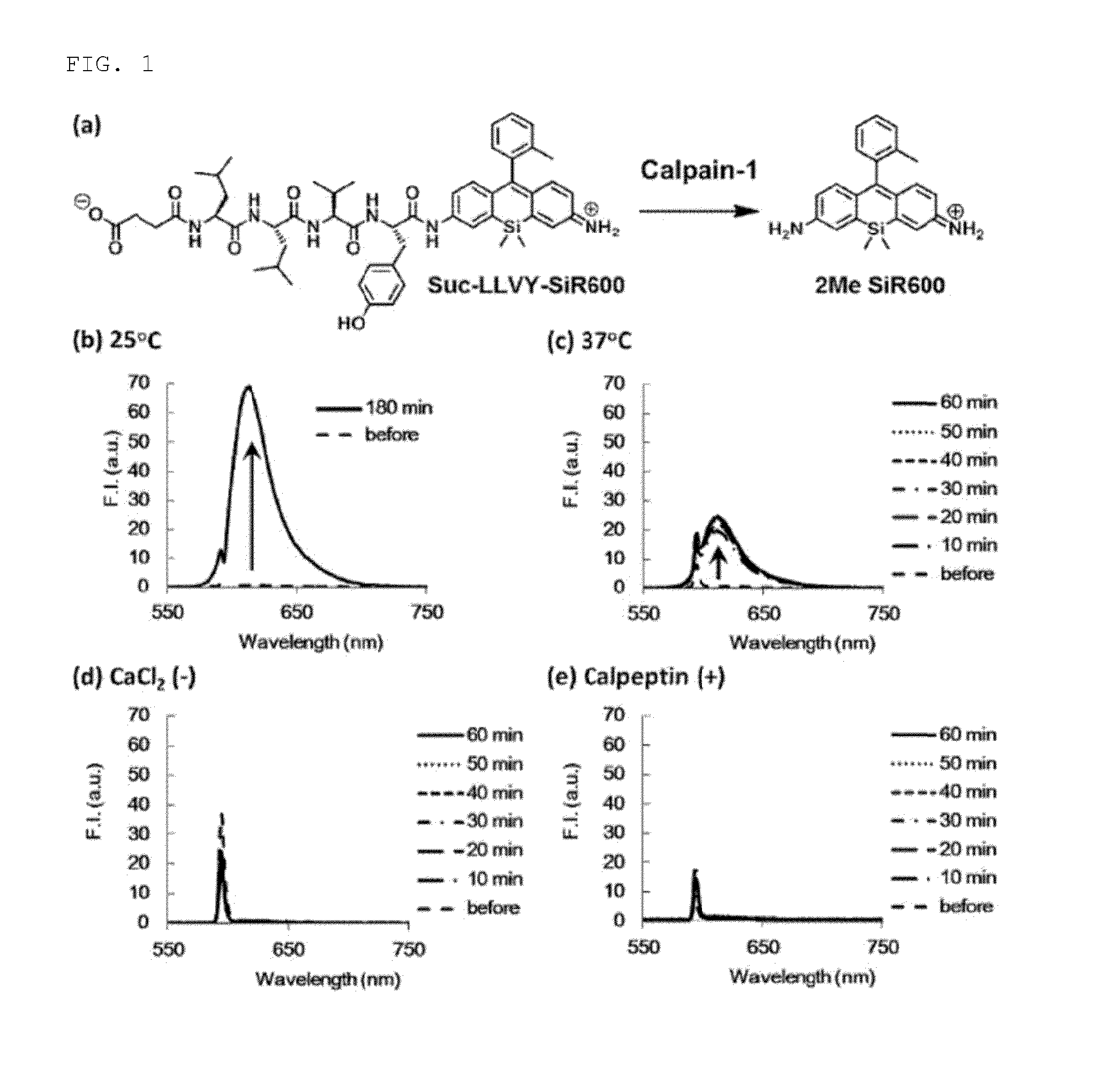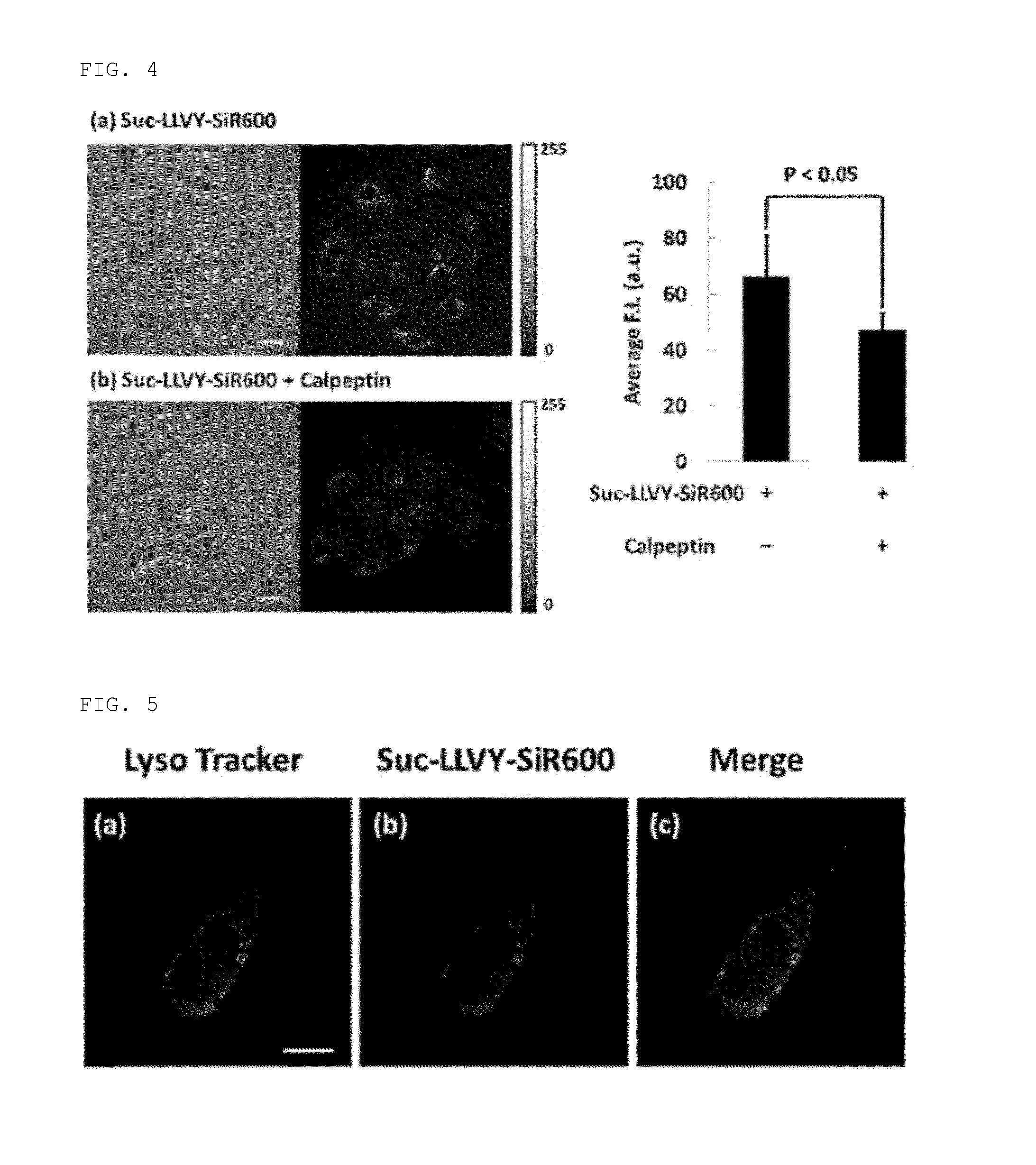Fluorescent probe for detecting activity of calpain
a fluorescent probe and activity technology, applied in the field of red fluorescent probes, can solve the problems of combination use, difficult use, and fura-2, and achieve the effect of broadening the multicolor imaging of calpain and excellent optical stability
- Summary
- Abstract
- Description
- Claims
- Application Information
AI Technical Summary
Benefits of technology
Problems solved by technology
Method used
Image
Examples
examples
[0047]The present invention is described in more detail below using examples, but the scope of the present invention is not limited by the examples described below. In the examples, Me refers to a methyl group.
examples 1 to 3
[0048]Three types of the compound of the present invention were synthesized in accordance with Synthesis Scheme 1 below.
[0049]Using 9-o-toluyl-9H-Si-xanthene-3,6-diamine (1) (of which synthesis method is disclosed in PCT / JP2012 / 53855) as a starting material compound, a compound to which an oligopeptide residue (Leu-Leu-Val-Tyr, Thr-Pro-Leu-Leu, Leu-Met) has been introduced via the steps shown in the following scheme (Suc-LLVY-SiR600:Suc refers to a succinyl group; Suc-TPLL-SiR600 and Boc-LM-SiR600:Boc refers to a tert-butoxycarbonyl group) was synthesized.
[Chemical Formula 9]
[0050]
[0051]Side-chain-protected peptides (2, 4, 6)
[0052]2
[0053]HRMS (ESI+): m / z Found 741.4450. calculated 741.4415 for [M+Na]+ (+3.6 mmu)
[0054]4
[0055]HRMS (ESI+): m / z Found 677.4097. calculated 677.4102 for [M+Na]+ (−0.4 mmu)
Boc-Leu-Met-OH [Chemical Formula 12][0056]6
[0057]HRMS (ESI+): m / z Found 385.1773. calculated 385.1811 for [M+Na]+ (+3.8 mmu)
[0058]Side-chain-protected peptides (2, 4, 6) were synthesized ...
example 1
[0059]
[0060]9-o-toluyl-9H-Si-xanthene-3,6-diamin (3.6 mg, 10.5 μmol) was dissolved in DMF (0.5 mL), side-chain-protected peptide 2 (8.3 mg, 11.5 μmol), HATU (8.7 mg, 23.0 μmol), and DIPEA (8 μL, 46.1 μmol) were added, and the system was stirred for 21 hours at room temperature. Water was added to the reaction mixture, the resulting mixture was extracted using dichloromethane and washed using a saline solution. The organic layer was dried using sodium sulfate, and the solvent was then distilled out under reduced pressure. The residue was dissolved in dicholomethane (6 mL), p-chloranil (4 mg, 0.0163 mmol) was added, the system was stirred for 1 hour at room temperature, and the solvent was then distilled out under reduced pressure. Trifluoroacetic acid (4 mL) was added to the residue, the system was stirred for 1 hour at room temperature, and the solvent was then distilled out under reduced pressure. The residue was refined using HPLC (eluent, from 32% acetonitrile / 0.1% trifluoroaceti...
PUM
| Property | Measurement | Unit |
|---|---|---|
| fluorescent | aaaaa | aaaaa |
| fluorescence intensity | aaaaa | aaaaa |
| red fluorescent probe | aaaaa | aaaaa |
Abstract
Description
Claims
Application Information
 Login to View More
Login to View More - R&D
- Intellectual Property
- Life Sciences
- Materials
- Tech Scout
- Unparalleled Data Quality
- Higher Quality Content
- 60% Fewer Hallucinations
Browse by: Latest US Patents, China's latest patents, Technical Efficacy Thesaurus, Application Domain, Technology Topic, Popular Technical Reports.
© 2025 PatSnap. All rights reserved.Legal|Privacy policy|Modern Slavery Act Transparency Statement|Sitemap|About US| Contact US: help@patsnap.com



